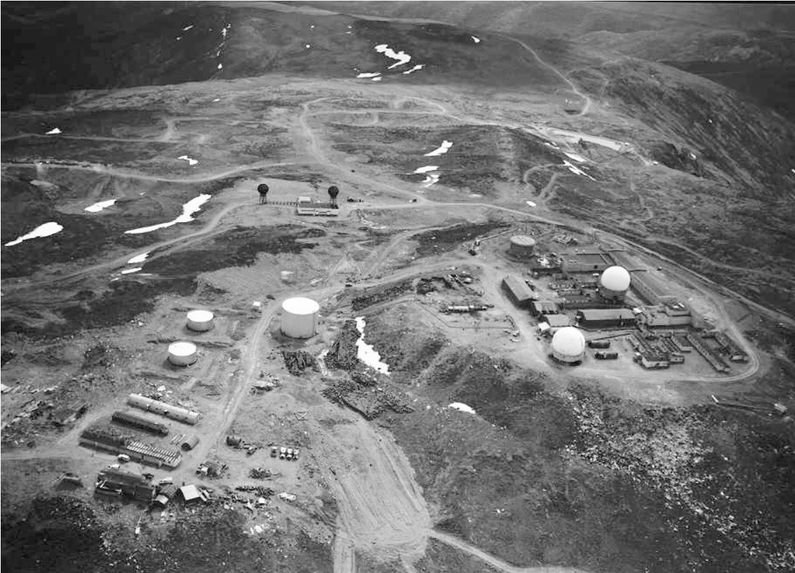Indian Mountain Air Force Station
|
Indian Mountain Air Force Station (1953-1983, 1984-Present) - A Cold War U.S. Air Force Station, part of the Alaska AC&W Radar Network. Initially functioned as a Ground Control Intercept (GCI) radar site, with a Permanent System ID of F-16. Later redesignated a surveillance site feeding manual track data to Murphy Dome Direction Center. Became a minimally attended radar site in 1984 and was redesignated as Indian Mountain Long-Range Radar Site with a JSS ID of A-03. Now feeds radar track data to the FAA Anchorage ARTCC (ZAN) and to the Elmendorf NORAD Regional Air Operations Center (RAOC). Active Long-Range Radar Site (LRRS) with an FAA ID of ZUTO.
Indian Mountain AFS Construction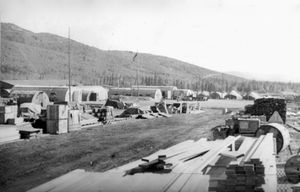 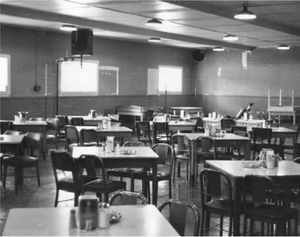 In 1951, when two gaps were discovered in the interior Alaska radar system coverage, there was a push to provide two ground-control intercept (GCI) sites to cover these areas that same year. The normal contracting and construction process would have delayed construction at least one year and perhaps two or three years given the short construction season in Alaska. The decision was made to build a minimal station using military personnel with scrounged funds and materials and then backfill with more permanent facilities using contractors. Military engineer construction personnel (807th Engineering Aviation Battalion) were selected to build the facility along with the first set of personnel who would man the radar site from Detachment F-16 of the 143rd ACWS, 143rd ANG. They ran the site until December 1952, when the 708th AC&WS took over operating the site until 1983. The site became operational in November 1953 with an FPS-3 search Radar The 807th began construction on 18 Jul 1951 by upgrading an airstrip that once served a gold mine and then building an eight-mile road to the top of Indian Mountain. The airstrip came to have a 7.1% slope which was said to be the steepest of the Alaska radar site airstrips. Indian Mountain was the only Alaska split site not to have a tram connecting the upper and lower sites and it was one of two sites supplied completely by air.
Indian Mountain AFS OperationsInitial radar equipment included the FPS-3 search radar. A FPS-6 height-finder radar was added in 1957. The radars were upgraded to one FPS-20 search radar and one FPS-90 height-finder radar. Later the FPS-20 was upgraded to a FPS-93A search radar. Aircraft track data from these radars was manually plotted on plotting boards and passed to the Murphy Dome Manual Direction Center on voice circuits. In 1965 the FYQ-9 Semiautomatic Data Processing and Display System was implemented on Alaska AC&W radar sites automating the passing of track data to the direction centers. The result was reduced manpower requirements and increased efficiency. Further reductions came on 1 Oct 1977 when the Alaska Air Command (ACC) contracted with RCA Services for site support services. This was a part of an Air Force effort to reduce remote tours. 103 military positions were deleted. The remaining were primarily in operations. JSS common digitizers were installed on the AC&W radars sites, including Indian Mountain, by 1982. This upgrade enabled transmission of radar track data via satellite to the new Elmendorf JSS Regional Operations Control Center (ROCC) near Anchorage. The Elmendorf JSS ROCC was activated on 14 Jun 1983 and that event triggered a series of events that included the closure of the AC&W sites, the disbandment of the AC&W Squadrons, the creation of Long-Range Radar Sites (LRRS) with full contractor operation and maintenance and new FPS-117 3D radars.
The Indian Mountain AFS was deactivated on 1 Nov l983 even before the FPS-117 radars were installed.
Indian Mountain Long-Range Radar Site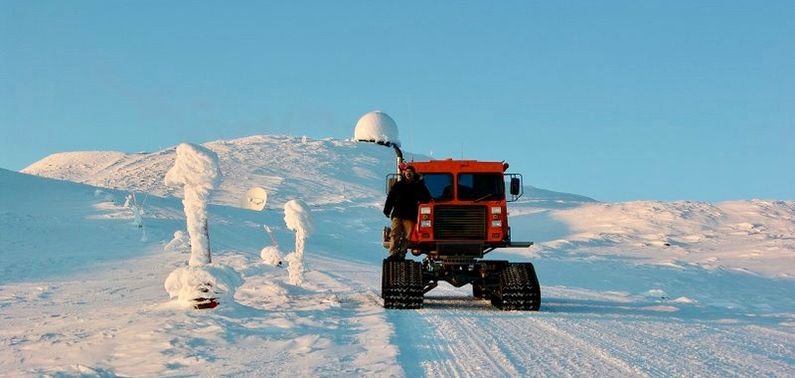 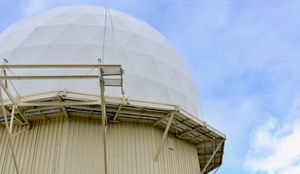 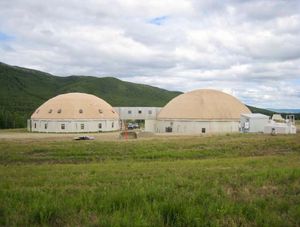 A new FPS-117 Minimally Attended Radar (MAR) was installed in July-September 1984, was operational on 10 Oct 1984 and was re-designated as Indian Mountain Long-Range Radar Site operated and maintained by contractors. The Long-Range radar site was connected to the Elmendorf JSS Regional Operations Control Center (ROCC) which was activated on 14 Jun 1983. The FPS-117 radar fed data to the ROCC FYQ-93 computers via satellite. The Elmendorf ROCC evolved into a Regional Air Operations Center (RAOC) which now operates with the Battle Control System-Fixed (BCS-F) FYQ-156 computer system. The RAOC is currently a component of the Alaska NORAD Region (ANR) and is operated by active Alaska Air National Guard members, Canadian servicemembers, and active duty augmentees. Elmendorf AFB is now a part of Joint Base Elmendorf-Richardson. By 2011 the MAR FPS-117 radars were outdated and increasingly unsupportable because parts and components were no longer available. In 2011 the U.S. Air Force awarded Lockheed Martin $46.8 million in contract options to begin modernization of 29 long-range radars. Under the EPRP contract, Lockheed Martin was to modernize 15 radars in Alaska including Indian Mountain. The last FPS-117 site was upgraded in June 2015. The EPRP program replaced four major subassemblies on the FPS-117: the Maintenance and Control System, the Beacon system, the Uninterruptable Power Supply/Communications Rack, and Local Control Terminals, which allow remote monitoring, troubleshooting, and control of the radars. The modifications reduced the line-replaceable unit count by approximately 80 percent, easing maintenance and the number of parts on the shelf. The program is expected to extend the supportably of the radar thru 2025.
Physical PlantThe physical plant of the site was originally divided into an upper main site, a cantonment area below. The upper site housed the radar towers, operations, and backup generators. The cantonment area housed the enlisted quarters (BAQ), the bachelor officer's quarters (BOQ), the orderly room, the dining hall and other support areas in a single large two-story composite building. A separate recreation hall was connected to the composite building. No family housing was provided as this was considered a remote unaccompanied tour (1 year). In the 1980s Indian Mountain received new composite buildings to house MAR facilities. The untraditional structures consisted of two aluminum, double geodesic domes, one housing personnel, and the other housing industrial operations with a connecting passageway. Air-Ground (A-G) CommunicationsSeparate radio facilities housed the radio transmitter and receiver equipment for communicating with aircraft. Indian Mountain White Alice Communications Site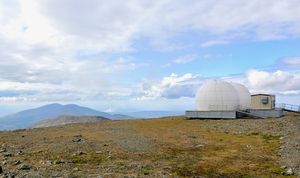 After HF systems proved inadequate for command and control communications, the Air Force implemented the White Alice Communications System. This was a system of tropospheric scatter and microwave radio relay sites constructed during the mid-1950s to provide reliable communications to Alaska Air Command (AAC) AC&W system. The Indian Mountain WACS was operational on 7 Feb 1958. Facilities included a 4,480 square-foot equipment building that was originally comprised of four separate buildings and three POL storage tanks with a capacity of 2,550 barrels. A single composite building replaced the original structures in 1961 at a cost of $2,280,000. The specific links from Indian Mountain (UTO) as/of July 1977 were:
The Indian Mountain WACS was inactivated in May 1979 and replaced by an Alascom-owned satellite earth terminal.
Current StatusActive long-range radar site but most of the old AC&W site buildings have been demolished. The site has also had an environmental remediation project that has further erased signs of the old AC&W site and the White Alice tropo site. The facilities that remain from the various periods of activity are listed below.
See Also:
Sources:
Links:
Visited: No
| |||||||||||||||||||||||||
